1993 BUICK LESABRE high beam
[x] Cancel search: high beamPage 14 of 324
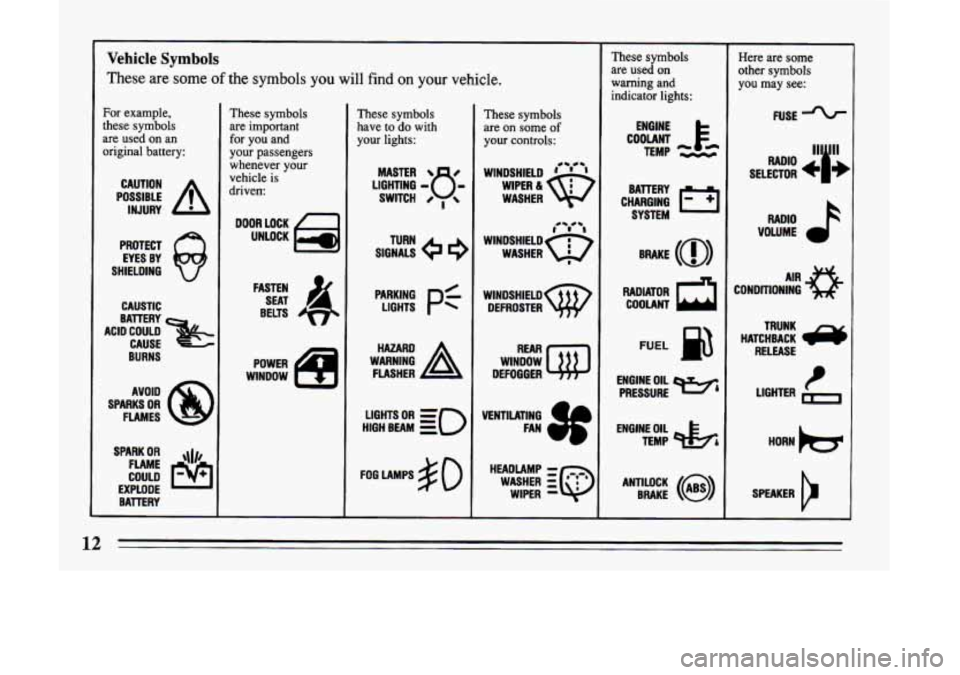
Vehicle Symbols
These
are some of the symbols you will find on your vehicle.
For example,
these symbols
are used on an
original battery:
POSSIBLE A
CAUTION
INJURY
PROTECT EYES BY
SHIELDING
Q
CAUSTIC
BURNS AVOID
SPARKS
OR
FLAMES
SPARK
OR ,\I/,
COULD FLAME
EXPLODE BATTERY
These symbols
are important
for you and
your passengers
whenever your
vehicle is
driven
DOOR LOCK
UNLOCK
FASTEN SEAT
4
BELTS
WINDOW POWER
These symbols
have
to do with
your lights:
LIGHTING - 8 -
MASTER 8
SWITCH 0 ,
SIGNALS e 9
TURN
LIGHTS
Pf
HIGH BEAM OR = =o
FOG LAMPS # 0
These symbols
are on some
of
your controls:
WINDSHIELD ' ' ' 4- e-
WASHER
wlNDsHIELDw DEFROSTER
WINDOW
DEFOGGER
HEADLAMP
- r~.c.r
WASHER :Q
WIPER -
These symbols
are used on
warning and
indicator lights:
COOLANT F*
TEMP -.--
ENGINE
CHARGING
I-1
BATTERY SYSTEM
RADIATOR
a
COOLANT
FUEL
ENGINE OIL
PRESSURE
TEMP OIL
&
ANTILOCK (@)
BRAKE
Here are some
other symbols
you
may see:
FUSE
RADIO >
VOLUME
CONDITIONING
AIR 33
HATCHBACK /y
TRUNK
RELEASE
t LIGHTER
Page 59 of 324

@ Part 2 Features & Controls I
I
L-
Here you can learn about the many standard and optional features on your Buick. and information on starting. shifting
and braking
. Also explained are the instrument panel and the warning systems that tell you if everything is working
properly
.. and what to do if you have a problem .
Part 2 includes:
Keys
........................................................................\
.... 58
DoorLocks ....................................................................... \
59
NewVehicleBreak-In .............................................................. 68
StartingtheEngine ................................................................. 70
ShiftingtheTransaxle .............................................................. 73
Windows ........................................................................\
. 82
Tilt Steering Wheel ................................................................ 84
Multi-Function Lever ............................................................... 85
TunrandLaneChangeSignals ................................................... 85
Headlight High-Low Beam Changer .............................................. 87
Windshield Wipermasher ...................................................... 87
CruiseControl ................................................................ 89
Instrumentpanel ................................................................... 104
Speedometer and Odometer ..................................................... 105
Warning Lights and Gages ...................................................... 106
57
Page 87 of 324
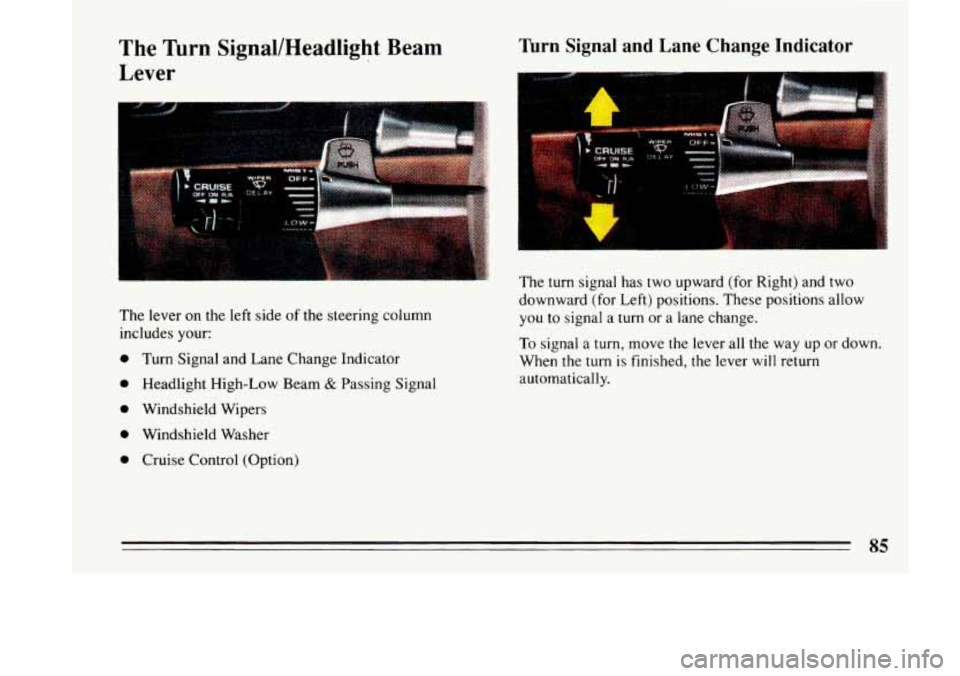
The Turn Signal/Headlight Beam
Lever
The lever on the left side of the steering column
includes your:
0 Turn Signal and Lane Change Indicator
0 Headlight High-Low Beam & Passing Signal
0 Windshield Wipers
0 Windshield Washer
0 Cruise Control (Option)
Turn Signal and Lane Change Indicator
bi
The turn signal has two upward (for Right) and two
downward (for Left) positions. These positions allow
you to signal a turn
or a lane change.
To signal a turn, move the lever all the way up or down.
When
the turn is finished, the lever will return
automatically.
85
Page 89 of 324

some jurisdictions may require that you operate your
lower beam lamps with fog lamps at all times, or that
headlamps be turned on whenever you must
use your
windshield wipers.
In addition, most jurisdictions
prohibit driving solely with parking lamps, especially at
dawn or dusk. It
is recommended that you check with
you own State or Provincial highway authority for
applicable lighting regulations.
Headlight High-Low Beam
’ To change the headlights
from low beam to high or
high to low, pull the turn
signal lever all the way
toward you. Then release it.
When the high beams are
on, this blue light on the
instrument panel also will
be on.
Windshield Wipers
... ,rll
You control the windshield wipers by turning the band
marked “WIPER.”
For a single wiping cycle, turn the band to “MIST.”
Hold it there
until the wipers start, then let go. The
wipers will stop after one cycle. If you want more
cycles, hold the band
on “MIST” longer.
You can set the wiper speed for a long
or short delay
between wipes. This can be very
useful in light rain or
snow. Turn the band
to choose the delay time. The
closer to
“LO,” the shorter the delay.
87
Page 172 of 324
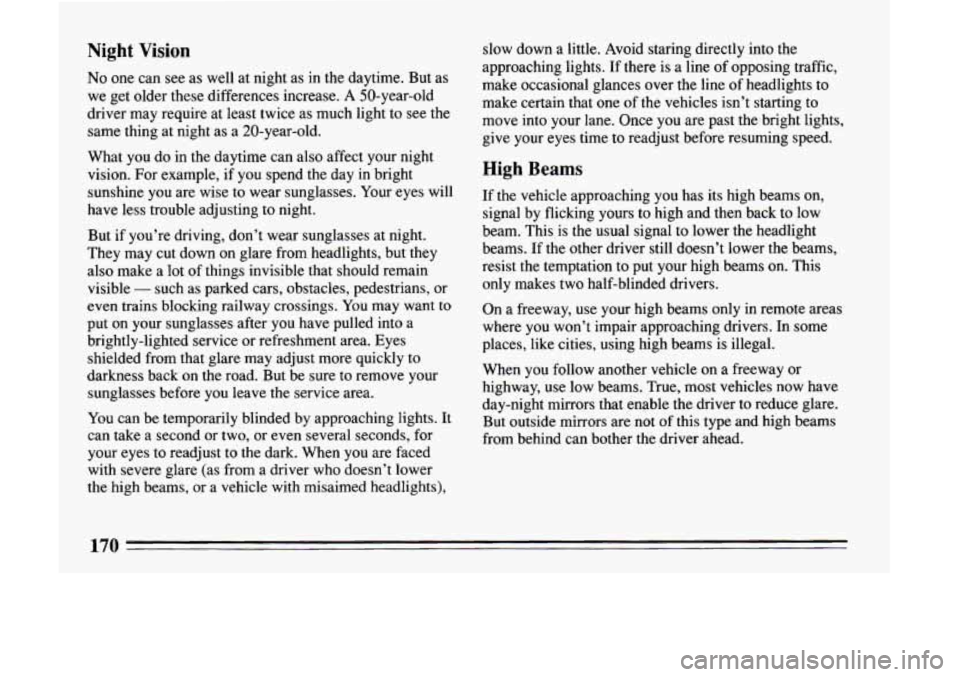
Night Vision
No one can see as well at night as in the daytime. But as
we get older these differences increase.
A SO-year-old
driver may require at least twice as much light to see the
same thing at night as a 20-year-old.
What you do in the daytime can also affect your night
vision. For example, if you spend the day
in bright
sunshine you are wise to wear sunglasses. Your eyes will
have less trouble adjusting to night.
But if you’re driving, don’t wear sunglasses at night.
They may cut down on glare from headlights, but
they
also make a lot of things invisible that should remain
visible
- such as parked cars, obstacles, pedestrians, or
even trains blocking railway crossings. You may want to
put on your sunglasses after you have pulled into
a
brightly-lighted service or refreshment area. Eyes shielded from that glare may adjust more quickly to
darkness back on the road. But be sure to remove your sunglasses before you leave the service area.
You can be temporarily blinded by approaching lights. It
can take a second
or two, or even several seconds, for
your eyes to readjust to the dark. When you are faced
with severe glare (as from
a driver who doesn’t lower
the high beams, or a vehicle with misaimed headlights), slow down
a little. Avoid staring directly into the
approaching lights. If there is a line of opposing traffic,
make occasional glances over the line of headlights to
make certain that one of the vehicles isn’t starting to
move into your lane. Once you are past the bright lights,
give your eyes time to readjust before resuming speed.
High Beams
If the vehicle approaching you has its high beams on,
signal by flicking yours to high and then back
to low
beam. This is the usual signal to lower the headlight
beams. If the other driver still doesn’t lower the beams,
resist the temptation to put your high beams on. This only makes two half-blinded drivers.
On a freeway, use your high beams only in remote areas
where you won’t impair approaching drivers. In some
places, like cities, using high beams is illegal.
When you follow another vehicle on a freeway or
highway, use low beams. True, most vehicles now have day-night mirrors that enable the driver to reduce glare. But outside mirrors are not of this type and high beams
from behind can bother the driver ahead.
170
-
Page 176 of 324

Fog can occur with high humidity or heavy frost. It can
be so mild that you can see through it for several
hundred feet (meters). Or it might be
so thick that you
can see only a few feet (meters) ahead. It may come
suddenly to an otherwise clear road. And it can be a
major hazard.
When
you drive into a fog patch, your visibility will be
reduced quickly. The biggest dangers are striking the
vehicle ahead or being struck by the one behind. Try to
“read” the fog density down the road. If the vehicle
ahead starts to become less clear or, at night, if the
taillights are harder to see, the fog is probably
thickening. Slow down to give traffic behind you a
chance to slow down. Everybody then has a better
chance to avoid hitting the vehicle ahead.
A patch of dense fog may extend only for a few feet
(meters) or for miles (kilometers); you can’t really tell
while you’re in
it. You can only treat the situation with
extreme care.
One common fog condition
-- sometimes called mist or
ground fog
-- can happen in weather that seems perfect,
especially at night or in the early morning in valley and
low, marshy areas. You can be suddenly enveloped in
thick, wet haze that may even coat your windshield.
You
can often spot these fog patches or mist layers with your
headlights. But sometimes they can be waiting for
you
as you come over a hill or dip into a shallow valley.
Start your windshield wipers and washer, to help clear
accumulated road dirt. Slow down carefully.
Tips on Driving in Fog
If you get caught in fog, turn your headlights on low
beam, even in daytime. You’ll see
-- and be seen --
better.
Don’t use your high beams. The light will bounce
off the
water droplets that make up fog and reflect back at you.
Use your defogger. In high humidity, even a light
buildup of moisture
on the inside of the glass will cut
down on your already limited visibility. Run your
windshield wipers and washer occasionally. Moisture
can build up on the outside glass, and what seems
to be
fog may actually be moisture on the outside of your
windshield.
Treat dense fog as an emergency. Try to find a place
to
pull off the road. Of course you want to respect
another’s property, but you might need to put something
between
you and moving vehicles -- space, trees,
telephone poles, a private driveway, anything that
removes you from other traffic.
If visibility is near zero and you must stop but are
unsure whether you are away from the road, turn your
Page 276 of 324
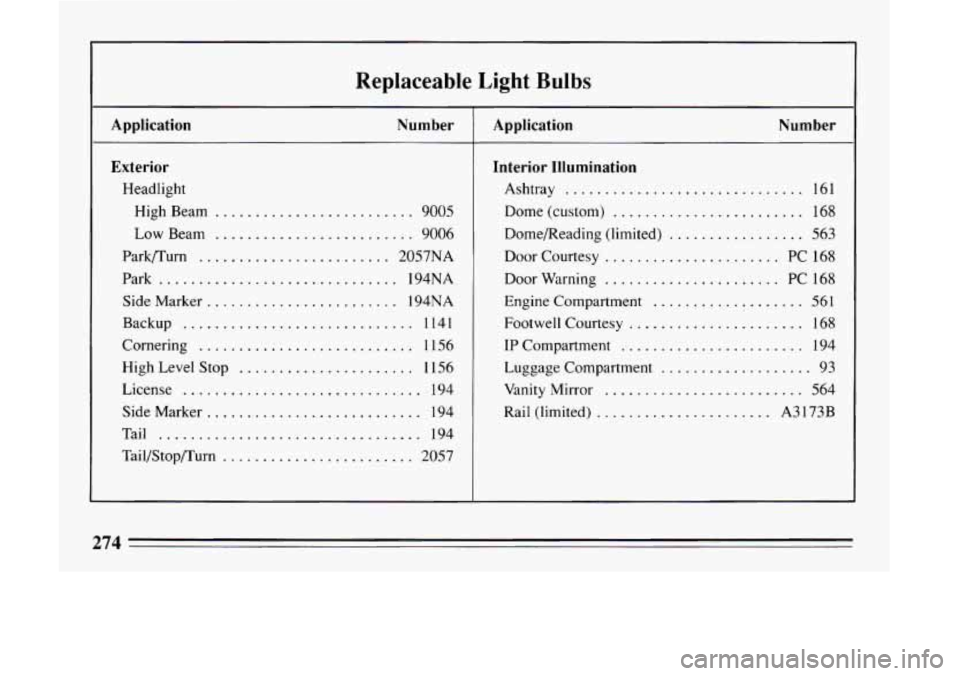
Replaceable Light Bulbs
Application Number
Exterior
Headlight High Beam
......................... 9005
Low Beam
......................... 9006
Parknurn
........................ 2057NA
Park
.............................. 194NA
Side Marker
........................ 194NA
Backup
............................. 1141
Cornering
........................... 1156
High Level Stop
...................... 1156
License
.............................. 194
Side Marker
........................... 194
Tail ................................. 194
Tail/Stop/Turn
........................ 2057
Application Number
Interior Illumination
Ashtray .............................. 161
Dome (custom)
........................ 168
Domemeading (limited)
................. 563
Door Courtesy ...................... PC 168
Door Warning
...................... PC 168
Engine Compartment
................... 561
Footwell Courtesy ...................... 168
IP Compartment ....................... 194
Luggage Compartment
................... 93
Vanity Mirror
......................... 564
Rail (limited) ...................... A3173B
274
Page 311 of 324
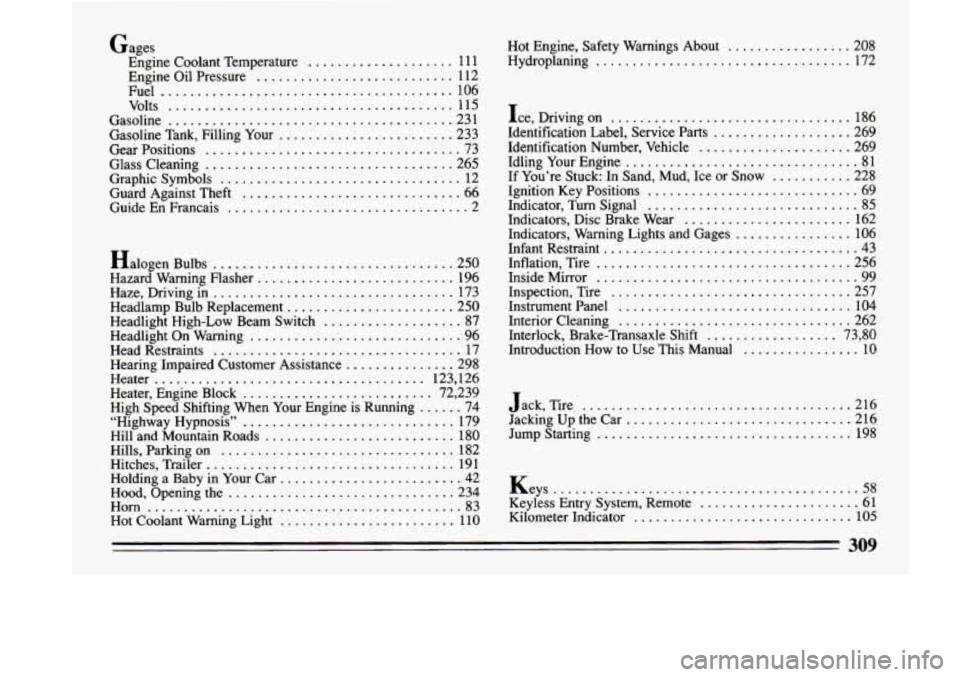
Gages Engine Coolant Temperature
.................... 11 1
Engine Oil Pressure
........................... 112
Fuel
........................................ 106
Volts
....................................... 115
Gasoline
....................................... 231
Gasoline Tank. Filling Your
........................ 233
Gear Positions
................................... 73
Glass Cleaning
.................................. 265
Graphic Symbols
................................. 12
Guard Against Theft
.............................. 66
Guide En Francais
................................. 2
I
H
H
H
H
H
H
H
H
H
H
“I
H
H
H
H
H
H
H
Ialogen Bulbs ................................. 250
[azard Warning Flasher
........................... 196
[aze. Driving in
................................. 173
[eadlamp Bulb Replacement
....................... 250
[eadlight On Warning
............................. 96
[ead Restraints
.................................. 17
[earing Impaired Customer Assistance
............... 298
[eater
..................................... 123. 126
.eater. Engine Block
.......................... 72. 239
Highway Hypnosis”
............................. 179
:ill and Mountain Roads
.......................... 180
ills. Parking on
................................ 182
.itches. Trailer
.................................. 191
:olding a Baby in Your Car
......................... 42
.ood. Opening the
............................... 234
:orn ........................................... 83
:ot Coolant Warning Light
........................ 110
[eadlight High-Low Beam Switch ................... 87
:igh Speed Shifting When Your Engine is Running
...... 74 Hot Engine. Safety Warnings About
................. 208
Hydroplaning ................................... 172
Ice. Driving
on ................................. 186
Identification Label. Service Parts
................... 269
Identification Number. Vehicle
..................... 269
Idling Your Engine
................................ 81
If You’re Stuck: In Sand. Mud. Ice or Snow
........... 228
Ignition Key Positions
............................ -69
Indicator.
Turn Signal ............................. 85
Indicators. Disc Brake Wear ....................... 162
Indicators. Warning Lights and Gages
................ 106
Infant Restraint
................................... 43
Inflation. Tire
................................... 256
Inside Mirror
.................................... 99
Inspection. Tire
................................. 257
Instrument Panel
................................ 104
Interior Cleaning
................................ 262
Interlock. Brake-Transaxle Shift
.................. 73. 80
Introduction How to Use This Manual ................ 10
..................................... J ack. Tire 216
Jacking Up the Car
.............................. -216
Jump Starting
................................... 198
Keys
.......................................... 58
Keyless Entry System. Remote
...................... 61
Kilometer Indicator
.............................. 105
309
.._ .. .